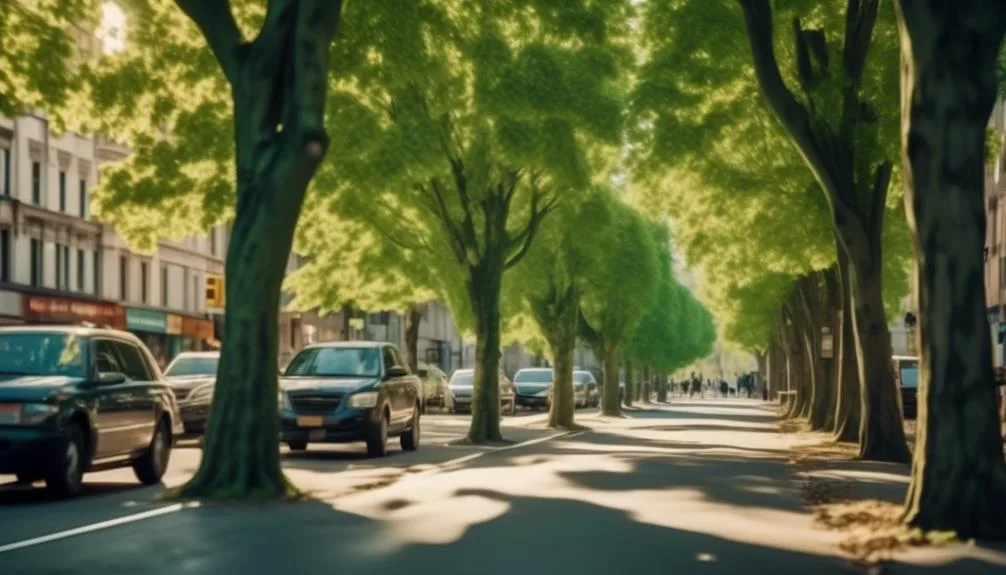Sycamore trees, known for their strength and endurance, are often considered for planting along urban streets. However, their suitability in bustling city settings raises important questions. Understanding the impact of sycamore trees on infrastructure, their resilience, and maintenance needs is crucial.
Before undertaking a street planting project, it's important to weigh the advantages and disadvantages of introducing sycamore trees to the urban environment.
Characteristics of Sycamore Trees
When considering suitable street planting options, sycamore trees stand out due to their impressive size and rapid growth, making them a popular choice for urban landscapes.
Their leaves are large, with a distinct five-lobed shape that adds a charming aesthetic to any street.
The bark of sycamore trees is another noteworthy feature, characterized by its unique texture, which peels away in patches to reveal a creamy white underbark, creating an eye-catching visual appeal.
This bark texture not only adds visual interest but also provides habitat for various insects and small creatures, contributing to the urban ecosystem.
The combination of their striking leaf shape and captivating bark texture makes sycamore trees an excellent choice for street planting, enhancing the beauty and biodiversity of urban environments.
Suitability for Urban Environments
The suitability of sycamore trees for urban environments lies in their ability to thrive in various soil and light conditions, making them adaptable and resilient additions to city streets.
Sycamore trees offer numerous environmental benefits, such as air purification, carbon dioxide absorption, and providing habitats for urban wildlife.
Their broad canopies also offer shade and help reduce the urban heat island effect, making them a valuable addition to city landscapes.
In urban environments where space is limited, tree species alternatives like the London plane tree and the Japanese zelkova also exhibit similar adaptability and resilience.
Considering the environmental benefits and the availability of suitable alternatives, sycamore trees stand as a suitable option for street planting in urban settings.
Impact on Infrastructure
Consider the potential impact of sycamore trees on urban infrastructure, particularly in relation to their root systems and the maintenance of sidewalks and roadsides.
Sycamore trees have aggressive root systems that can cause significant damage to pavements and underground infrastructure. The expansive root network of mature sycamore trees may lead to pavement lifting, creating trip hazards and increasing maintenance costs.
The root damage caused by sycamore trees can also compromise the stability of sidewalks and roadsides, posing safety risks for pedestrians and motorists. It's crucial to carefully assess the proximity of sycamore trees to infrastructure and employ appropriate root management techniques to mitigate the potential negative impact.
Regular monitoring and maintenance are essential to ensure that sycamore trees coexist harmoniously with urban infrastructure, minimizing the risks of pavement lifting and root damage.
Maintenance Requirements
To ensure the harmonious coexistence of sycamore trees with urban infrastructure, it's essential to implement proactive maintenance requirements that address the potential impact of their aggressive root systems on pavements and underground structures.
Proper pruning needs to be regularly carried out to manage the growth of the roots and branches, preventing them from causing damage to sidewalks and roads.
Additionally, establishing a suitable watering schedule is crucial to support the health of the trees while preventing overgrowth of their root systems.
By ensuring that these maintenance requirements are met, the potential issues associated with sycamore trees in urban areas can be effectively mitigated, allowing for their continued growth and contribution to the urban environment.
- Regular pruning to manage root and branch growth
- Establishment of a suitable watering schedule
- Implementation of proactive maintenance measures
Considerations for Street Planting
When selecting suitable trees for street planting, consider the environmental conditions and space limitations to ensure the long-term health and vitality of the urban landscape. Sycamore trees, known for their robust root systems, are resistant to soil compaction, making them suitable for urban environments. Their expansive tree canopy provides shade and contributes to the aesthetic appeal of the street.
However, it's crucial to consider pedestrian safety when planting sycamore trees along streets. Their root systems can potentially disrupt sidewalks and roads if not managed properly. To mitigate this, regular maintenance and pruning are necessary to prevent any interference with pedestrian pathways.
Additionally, selecting the appropriate tree cultivar that's best suited for urban settings can help alleviate potential issues with overgrowth and ensure the safety and enjoyment of the community.
Conclusion
Considering the sturdy nature and beautiful foliage of sycamore trees, they can indeed be a suitable option for street planting in urban environments. However, their large size and potential for root damage require careful consideration.
With proper maintenance and planning, sycamore trees can enhance city streets, providing shade and ecological benefits.
How can we make the most of their potential while addressing the challenges they pose?

My interest in trees started when I first saw the giant sequoias in Yosemite.
I was a teenager then, and I remember thinking, “I need to learn more about this.”
That moment stuck with me.
A few years later, I went on to study forestry at Michigan Tech.
Since graduating, I’ve worked in a mix of hands-on tree care and community education.
I’ve spent over ten years helping people understand how to plant, maintain, and protect the trees in their neighborhoods.
I don’t see trees as just part of the landscape.
They are living things that make a real difference in our daily lives.
